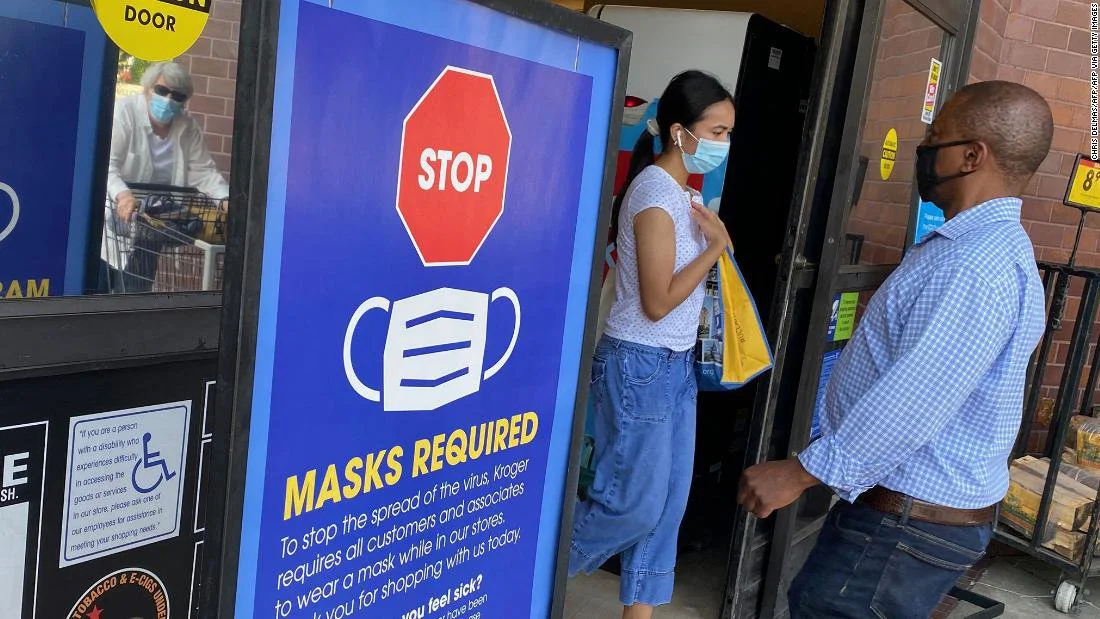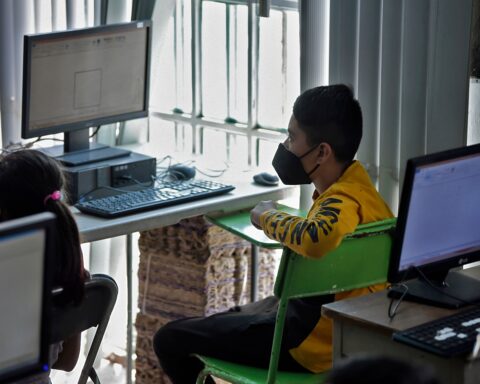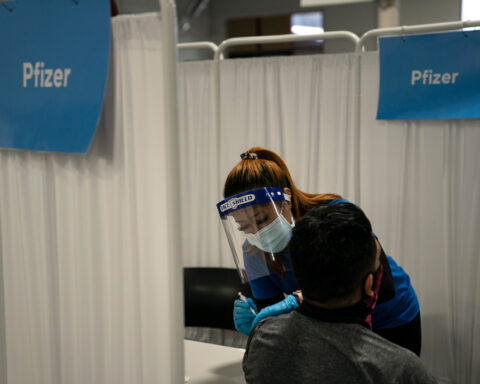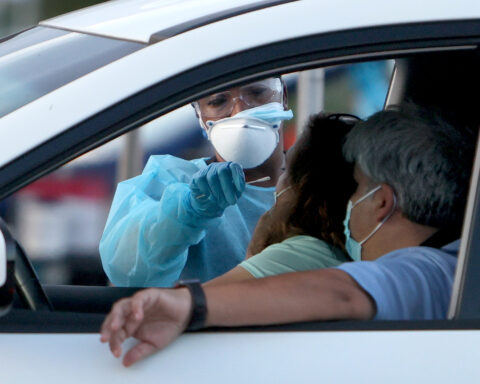You could almost hear the collective groan of frustration around the country Tuesday when the US Centers for Disease Control and Prevention again updated its guidance, encouraging more Americans and all schoolkids and teachers to wear face masks to stop the spread of Covid-19.
But the health community’s understanding of the coronavirus, its variants and vaccine efficacy has evolved with the virus itself, and this new guidance is based on new information.
The country missed President Joe Biden’s goal of vaccinating 70% of adults with at least one dose by July Fourth, what he’d wanted to frame as a day of US independence from Covid. Now, as the Delta variant spreads, the country is headed not toward independence, but back toward masking up.
The new guidance will set up yet another clash between federal government recommendations and the nine states — many where Covid is raging — that have banned school districts from requiring masks and have preempted cities and counties from imposing their own mask requirements.
What’s the new guidance?
- Children and adults in K-12 schools should wear masks, regardless of vaccination status. Period.
- Vaccinated Americans should wear masks indoors if they are in high or substantial transmission areas.
- The CDC wants local leaders in high transmission areas to support vaccination and universal masking.
What guidance hasn’t changed?
- The unvaccinated should always have been wearing masks in public, according to the CDC.
- Everyone who can should get vaccinated.
Why did the guidance change? Two reasons, according to CDC Director Dr. Rochelle Walensky, who briefed reporters Tuesday.
The vaccinated may spread the Delta variant. The more important of these is that the CDC now believes that vaccinated Americans, while protected from hospitalization and death, may spread the Delta variant more than previously thought.
Here’s how Walensky explained this new data:
“The Delta variant is showing every day its willingness to outsmart us and to be an opportunist in areas where we have not shown a fortified response against it,” she said of the Covid strain that now represents most US cases. “In recent days, I have seen new scientific data from recent outbreak investigations showing that the Delta variant behaves differently from past strains of the virus that cause Covid-19. Information on the Delta variant from several states and other countries indicates that in rare occasions, some vaccinated people infected with the Delta variant after vaccinations may be contagious and spread the virus to others. This new science is worrisome and, unfortunately, warrants an update to our recommendations.”
She also implied a second reason for the change.
Not enough people got vaccinated. “The highest spread of cases is happening in places with low vaccination rates and among unvaccinated people,” she said. “This moment and, most importantly, the associated illness, suffering and death could have been avoided with higher vaccination coverage in this country.”
RELATED: Tracking Covid-19 cases in the US
Where is transmission “high” or “substantial”? You can look for your own county at the CDC’s website. But those areas comprise more than half the country — nearly 47% are classified as “high” transmission areas by the CDC and more than 17% are classified as “substantial.”
A brief history of mask guidance. Plenty of Americans will be angry at a lack of consistency from the CDC and the nation’s public health policymakers, who have ricocheted all over the place on masks over the past 16 months of this pandemic:
- Warning against wearing masks so as not to deplete scarce supplies (March 2020)
- Recommending people wear cloth face coverings (April 2020)
- Recommending everyone wear a mask in public settings (July 2020)
- Clarifying for the vaccinated that it’s OK to not wear a mask outside (April 2021)
- Encouraging the vaccinated to take their masks off outdoors and indoors, except in certain circumstances (May 2021)
- Recommending that only unvaccinated students need to wear masks at school (earlier in July 2021)
Some locations are already re-masking. From Los Angeles to St. Louis and Chicago, some places have already reenacted mask guidance or requirements. The CDC recommendation will accelerate those moves.
The US House is masking up again too. The House attending physician sent out new guidance Tuesday requiring that “well-fitted, medical grade” masks be worn in all interior spaces in the House in light of the new CDC guidance.
It will also likely lead to a change of plans in many school districts preparing for the fall return and in some cases likely lead to a political clash.
“There’s been so many collisions between politics and science here,” Dr. Sanjay Gupta, CNN’s chief medical correspondent, said Tuesday. “If you look at the science, what the new science is saying, and this is different than May 13th, when the guidance initially changed from the CDC. ”
CNN has been tracking how US school districts will treat masks, and even before the new CDC guidance the nation’s three largest school districts — in New York City, Los Angeles and Chicago — had already made clear they would require masks in schools.
A separate CNN analysis has found that at least nine states — Arkansas, Arizona, Georgia, Iowa, Oklahoma, South Carolina, Texas, Utah and Vermont — have enacted legislation that prohibits districts from requiring masks in schools. The list of schools banning mask mandates has been constantly changing, but so far they are all states with Republican governors.
Among the top 12 districts in the country, all are requiring masks except those in Florida and Texas, where the governors have banned mask mandates in schools.
Overall, at least 14 of the 30 largest US districts are making masks optional for students in school, while another 13 are requiring them. As of Monday, the remaining three districts were undecided.
Texas Democrats have pleaded with Republican Gov. Greg Abbott to reverse a ban on masks in schools for the coming year.
In Florida, Republican Gov. Ron DeSantis supports vaccination but has been vehemently opposed to anyone in his state being asked by their state or local government to re-mask.
“There’s been talk about potentially people advocating at the federal level, imposing compulsory masks on kids,” DeSantis said last week. “We’re not doing that in Florida, OK? We need our kids to breathe. We need our kids to be able to be kids.”
Arkansas Gov. Asa Hutchinson, whose state is a Delta variant epicenter, has also rejected the idea of new mask regulations, in part because the GOP-controlled legislature passed a law rejecting them, but he also points out kids are less likely to get extremely sick.
“We need to get everyone else around that young child vaccinated,” Hutchinson, a Republican, told CNN’s Jake Tapper on Sunday. “That’s the cocoon. “That’s how we protect them.”
A closer look at the masking time line
Don’t wear them. Top infectious diseases expert Dr. Anthony Fauci to “60 Minutes” in March 2020, saying save them for health care workers: “There’s no reason to be walking around with a mask. When you’re in the middle of an outbreak, wearing a mask might make people feel a little bit better and it might even block a droplet, but it’s not providing the perfect protection that people think that it is. And, often, there are unintended consequences: People keep fiddling with the mask and they keep touching their face.”
Wear them! Then-CDC Director Dr. Robert Redfield in July 2020: “If we all wore face coverings for the next four, six, eight, 12 weeks across the nation, this virus transmission would stop.”
Why the evolution? Fauci on July 16, 2020, explaining why the guidance changed: “As the information changes, then you have to be flexible enough and humble enough to change how you think about things. And I think, you know, one of the important things that we’re emphasizing right now that really evolved from a situation that did change is our insistence now on wearing masks. I mean, masks are very important. They protect you from giving infection to someone else.”
Vaccinated people should ease them off. Walensky on April 27, 2021: “If you are fully vaccinated and want to attend a small outdoor gathering with people who are vaccinated and unvaccinated, or dine at an outdoor restaurant with friends from multiple households, the science shows if you are vaccinated, you can do so safely unmasked,” the CDC director said.
Vaccinated people should take them off. Walensky on May 13, 2021: “If you are fully vaccinated, you can start doing the things that you had stopped doing because of the pandemic,” she said. “We have all longed for this moment when we can get back to some sense of normalcy.”
Now, in areas of high or substantial transmission, the new guidance is that vaccinated people should put them back on.





